Long Exposure Short Pulse Synchronous Phase Lock Method for Capturing High Dynamic Surface Shape
Abstract
:1. Introduction
- LSPL: Long Exposure Short Pulse Synchronous Phase Lock
- VM: vibrating mirror
- LPW: laser pulse width
- : sampling location
- IOP: Interference optical path
2. Approach Overview
- The laser pulse must arrive at the VM just at the moment that the VM is reaching the .
- The interference pattern must be generated at the blur angle () within the dwell time ().
- The laser pulse controlled by the PSS must be strictly aligned with the SL, so the accuracy of the PSS must meet the condition that the synchronization accuracy is .
- Only one laser pulse is generated within the period of the camera’s exposure time to produce one interference pattern, otherwise the interference fringe captured by the camera will be blurred.
3. Experimental Setup
4. Results
4.1. Experimental Results with the Traditional Interferometer
4.2. Experimental Results Using LSPL
5. Discussion and Conclusions
- Unlike high-speed projection-imaging technology that uses expensive high-frequency cameras to capture dynamic images, our proposed method uses inexpensive commercial cameras to acquire the surface interference pattern vibrating at 3033 Hz using a frame rate as low as 10 fps.
- Acquiring the interference pattern at the sample location SL(i) has two meanings: (1) the one-dimensional turntable rotates at the corresponding angle according to the sampling location (SL) of the VM to be measured; and (2) the phase shifter moves a phase offset corresponding to SL(i) and a PSS is generated. The PSS synchronizes the laser pulse and the camera for the generation and acquisition of the interference fringe of the VM at SL(i). Since the frame frequency of the camera is 10 Hz, each image frame captured by the camera is separated by 303.3 VM vibration cycles, but they are all interference patterns captured at a fixed position SL(i) of each vibration cycle. When the turntable rotates from SL(−110) to SL(110) (a total of 221 SLs), all positions within a single vibration cycle of the VM are measured.
- Compared to the traditional interference methods, the proposed approach can realize dynamic surface shape measurement while the VM is vibrating, while the traditional interference method failed.
- In addition, the difference between our proposed approach and the traditional interference method is that the laser we used is a pulsed laser that can capture the dynamic surface shape on a single frame image using a single pulse.
- The proposed approach adopts the method of LSPL, where a PSS forms a nanosecond-precision phase-lock relationship between the VM’s phase and the laser pulse and camera acquisition.
- The constraint conditions for capturing the dynamic surface shape must be satisfied, such as “the laser pulse controlled by the PSS must be strictly aligned with the SL”.
- The experiment shows that the VM’s dynamic surface shape can be captured using only a single pulse within the period of the camera’s exposure time. If more than one pulse is emitted within the period of the camera’s exposure time, the interference patterns will be blurred.
- The experimental results verify the correctness of the LSPL approach.
Author Contributions
Funding
Acknowledgments
Conflicts of Interest
References
- Li, Q.; Feng, H.; Xu, Z.; Han, Y.; Huang, H. Review of computer stereo vision technique. Opt. Tech. 1999, 5, 71–73. [Google Scholar]
- Hsueh, W.J. 3D Surface Digitizing and Modeling Development at ITRI. Proc. SPIE 2000, 4080, 14–20. [Google Scholar]
- Addison, A.C. Virtualized Architectural Heritage: New Tools and Techniques. IEEE Multimed. 2000, 7, 26–31. [Google Scholar] [CrossRef]
- Hu, Z. Flexible Measuring Equipment 3 Coordinate Measuring Machine. Precise Manuf. Autom. 2006, 2, 57–58. [Google Scholar]
- Zhang, X.; Liu, J.; Xia, X. Design of Deep-sea Sonar Altimeter Based on PIC16C74. Microcomput. Inf. 2008, 24, 126–127. [Google Scholar]
- Chen, F.; Brown, G.M.; Song, M. Overview of Three-Dimensional Shape Measurement Using Optical Methods. Opt. Eng. 2000, 39, 10–22. [Google Scholar]
- Lu, Y. Progress on Laser Phase-shift Interferometry. Laser Infrared 1990, 20, 13–15. [Google Scholar]
- John, B.; Haubecker, H.; Geibler, P. Handbook of Computer Vision and Applications; Academic Press: Cardiff, UK, 1999. [Google Scholar]
- Gorthi, S.S.; Rastogi, P. Fringe projection techniques: Whither we are? Opt. Lasers Eng. 2010, 48, 133–140. [Google Scholar] [CrossRef] [Green Version]
- Salvi, J.; Pages, J.; Battle, J. Pattern codification strategies in structured light systems. Pattern Recognit. 2004, 37, 827–849. [Google Scholar] [CrossRef] [Green Version]
- Xian, T.; Su, X. Area modulation grating for sinusoidal structure illumination on phase-measuring profilometry. Appl. Opt. 2001, 40, 1201–1206. [Google Scholar] [CrossRef]
- Chen, L.; Quan, C.; Tay, C.J.; Fu, Y. Shape measurement using one frame projected saw tooth fringe pattern. Opt. Commun. 2005, 246, 275–284. [Google Scholar] [CrossRef]
- Nicodemus, F.E.; Richmond, J.C.; Hsia, J.J.; Ginsberg, I.W.; Limperis, T. Geometrical Considerations and Nomenclature for Reflectance; Radiometry Jones and Bartlett: Burlington, MA, USA, 1977; pp. 1–52. [Google Scholar]
- Massie, N.A.; Nelson, R.D.; Holly, S. High-performance real-time heterodyne interferometry. Appl. Opt. 1974, 18, 1797–1803. [Google Scholar] [CrossRef] [PubMed]
- Hao, Q.; Wang, S.; Hu, Y.; Tan, Y.; Li, T.; Wang, S. Two-step carrier-wave stitching method for aspheric and freeform surface measurement with a standard spherical interferometer. Appl. Opt. 2018, 57, 4743–4750. [Google Scholar] [CrossRef] [PubMed]
- Burning, J.H.; Herriott, D.R.; Gallagher, J.E.; Rosenfeld, D.P.; White, A.D.; Brangaccio, D.J. Digital Wave Front Measuring Interferometer for Testing Optical Surfaces and Lenses. Appl. Opt. 1974, 13, 2693–2703. [Google Scholar] [CrossRef] [PubMed]
- Dorband, B. Die 3-Interferogramm Method zur automatischen Streifenauswertung in rechnergesteuerten digitalten zweistrahlinterometern. Optik 1982, 60, 161–174. [Google Scholar]
- Takeda, M.; Ina, H.; Kobayashi, S. Fourier-transform method of fringe-pattern analysis for computer-based topography and interferometry. J. Opt. Soc. Am. 1982, 72, 156–160. [Google Scholar] [CrossRef]
- Frank, O.C.; Ryan, P.; Wellesley, E.P.; John, K.; Jason, C. A passive optical technique to measure physical properties of a vibrating surface. Proc. SPIE 2014, 9219, 1–12. [Google Scholar]
- Sappey, A.D. Optical imaging through turbid media with a degenerate four wave mixing correlation time gate. Appl. Opt. 1994, 33, 8346–8354. [Google Scholar] [CrossRef]
- Paciaroni, M. Single-shot two-dimensional ballistic imaging through scattering media. Appl. Opt. 2004, 43, 5100–5109. [Google Scholar] [CrossRef]
- Ambekar, R.; Lau, T.Y.; Walsh, M.; Bhargava, R.; Toussaint, K.C. Quantifying collagen structure in breast biopsies using second-harmonic generation imaging. Biomed. Opt. Exp. 2012, 3, 2021–2035. [Google Scholar] [CrossRef] [Green Version]
- Ren, Y.; Si, J.; Tan, W.; Zheng, Y.; Tong, J.; Hou, X. Speckle Suppression of OKG Imaging in Highly Turbid Medium Using SC-Assisted Fundamental Frequency. IEEE Photonics Technol. Lett. 2017, 29, 106–109. [Google Scholar] [CrossRef]
- Vellekoop, I.M.; Mosk, A.P. Focusing coherent light through opaque strongly scattering media. Opt. Lett. 2007, 32, 2309–2311. [Google Scholar] [CrossRef] [PubMed]
- Horstmeyer, R.; Ruan, H.; Yang, C. Guidestar-assisted wavefront-shaping methods for focusing light into biological tissue. Nat. Photonics 2015, 9, 563–571. [Google Scholar]
- Bertolotti, J.; Van Putten, E.G.; Blum, C.; Lagendijk, A.; Vos, W.L.; Mosk, A.P. Non-invasive imaging through opaque scattering layers. Nature 2012, 491, 232–234. [Google Scholar] [CrossRef] [PubMed]
- Katz, O.; Heidmann, P.; Fink, M.; Gigan, S. Non-invasive real-time imaging through scattering layers and around corners via speckle correlations. Nat. Photonics 2014, 8, 784–790. [Google Scholar] [CrossRef]
- Wu, T.; Dong, J.; Shao, X.; Gigan, S. Imaging through a thin scattering layer and jointly retrieving the point-spread-function using phase-diversity. Opt. Exp. 2017, 25, 27182–27194. [Google Scholar] [CrossRef] [PubMed] [Green Version]
- Shapiro, J.H. Computational ghost imaging. Phys. Rev. A 2008, 78, 061802. [Google Scholar]
- Bromberg, Y.; Katz, O.; Silberberg, Y. Ghost imaging with a single detector. Phys. Rev. A 2009, 79, 053840. [Google Scholar] [CrossRef] [Green Version]
- Xu, Y.; Yuan, Z. Distance measurement by computational ghost imaging. Optik 2013, 124, 5882–5884. [Google Scholar]
- Le, M.; Wang, G.; Zheng, H.; Liu, J.; Zhou, Y.; Xu, Z. Under water computational ghost imaging. Opt. Exp. 2017, 25, 22859–22868. [Google Scholar] [CrossRef]
- Xu, Z.H.; Chen, W.; Penuelas, J.; Padgett, M.; Sun, M.J. 1000 fps computational ghost imaging using LED-based structure illumination. Opt. Exp. 2018, 26, 2427–2434. [Google Scholar] [CrossRef] [PubMed] [Green Version]
- Chen, F.; Griffen, C.T.; Allen, T.E.; Brown, G.M. Measurement of shape and vibration using a single electronic speckle interferometry. Proc. SPIE 1996, 2860, 150–161. [Google Scholar]
- De Veuster, C.; Renotte, Y.L.; Berwart, L.; Lion, Y.F. Quantitative three-dimensional measurements of vibration amplitudes and phases as a function of frequency by Digital Speckle Pattern Interferometry. SPIE 1998, 3478, 322–333. [Google Scholar]
- Ruiz-Altisent, M.; Ruiz-Garcia, L.; Moreda, G.P.; Lu, R.; Hernandez-Sanchez, N.; Correa, E.C.; Diezma, B.; Nicolai, B.; García-Ramos, J. Sensors for product characterization and quality of specialty crops—A review. Comput. Electron. Agric. 2010, 74, 176–194. [Google Scholar] [CrossRef] [Green Version]
- Paulus, S.; Behmann, J.; Mahlein, A.K.; Plümer, L.; Kuhlmann, H. Low-cost 3D systems: Suitable tools for plant phenotyping. Sensors 2014, 14, 3001–3018. [Google Scholar] [CrossRef] [Green Version]
- Heist, S.; Lutzke, P.; Schmidt, I.; Dietrich, P.; Kühmstedt, P.; Tünnermann, A.; Notni, G. High-speed three-dimensional shape measurement using GOBO projection. Opt. Lasers Eng. 2016, 87, 90–96. [Google Scholar] [CrossRef]

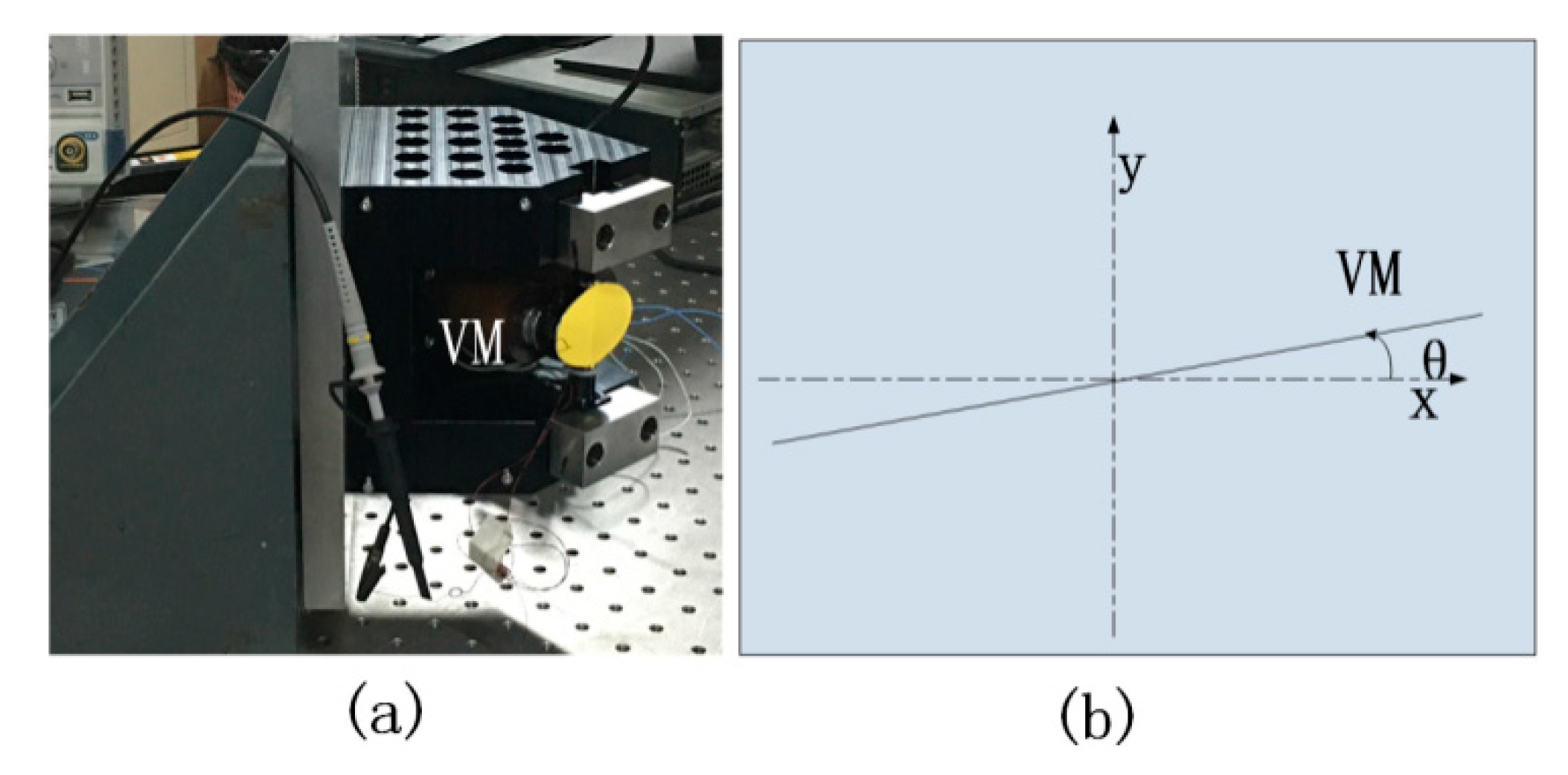
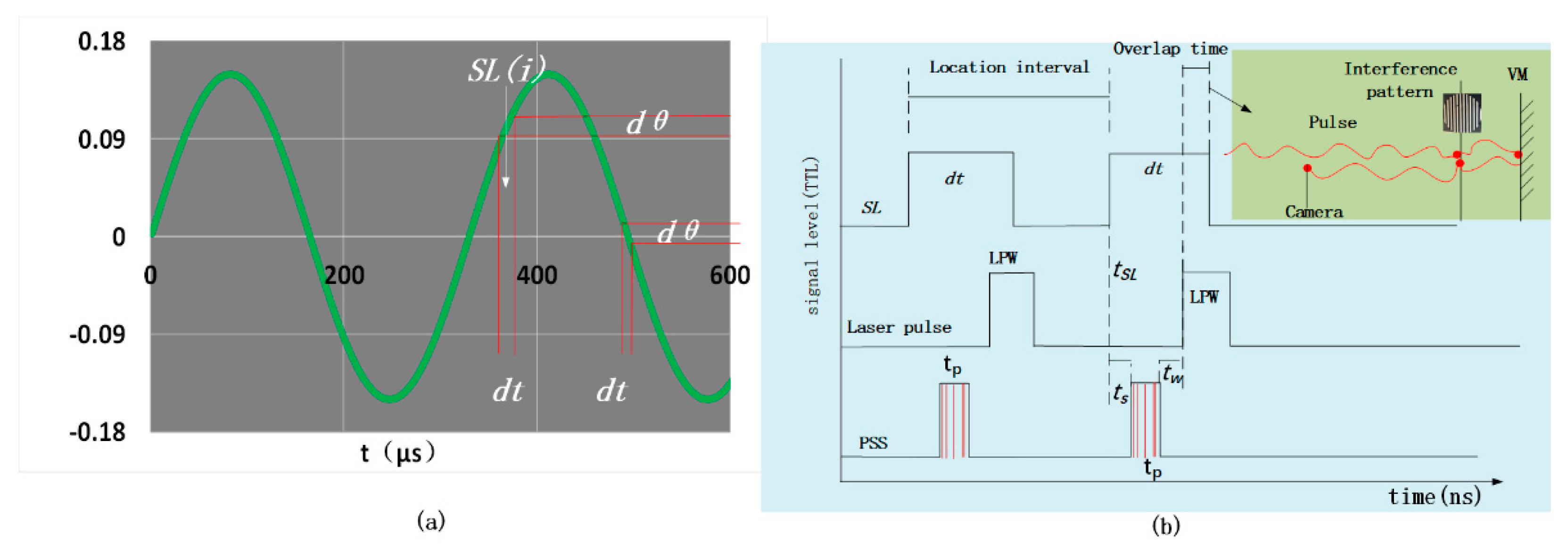

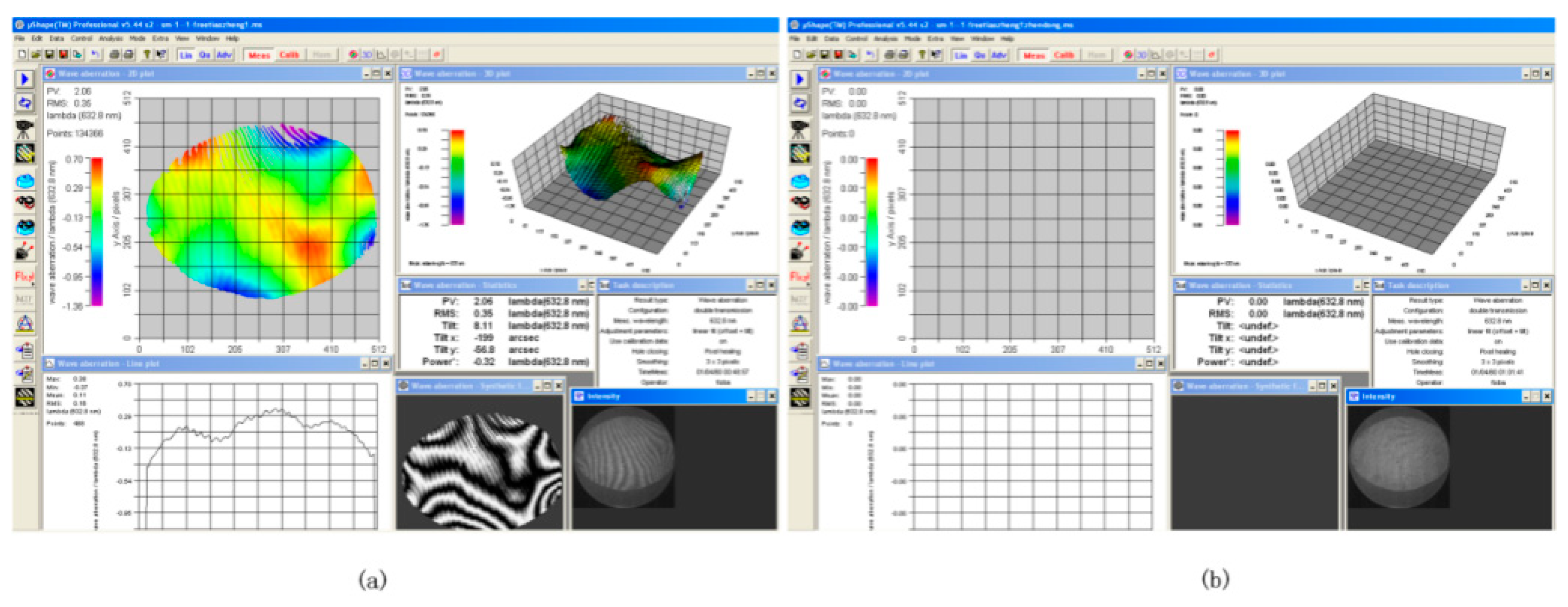
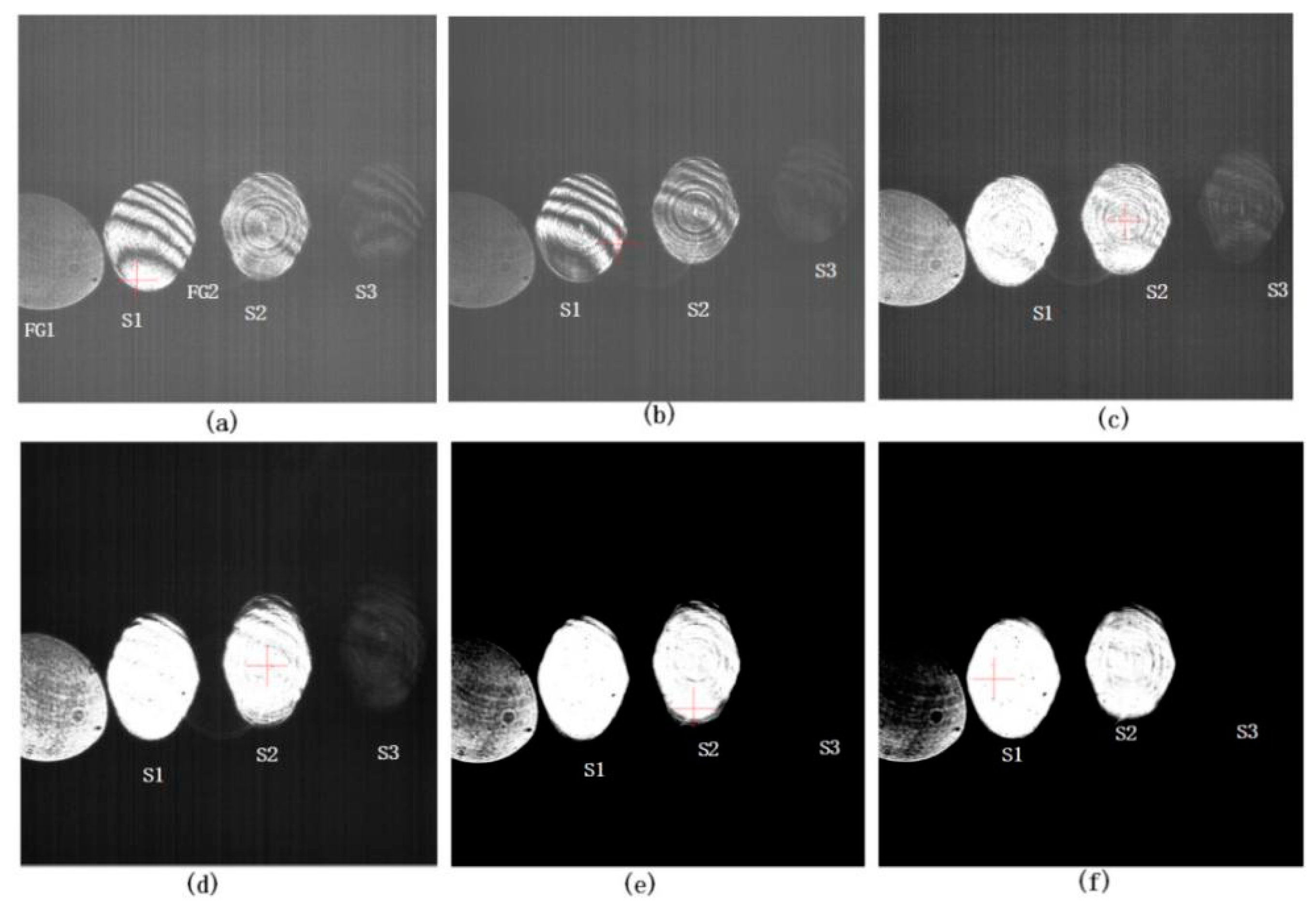
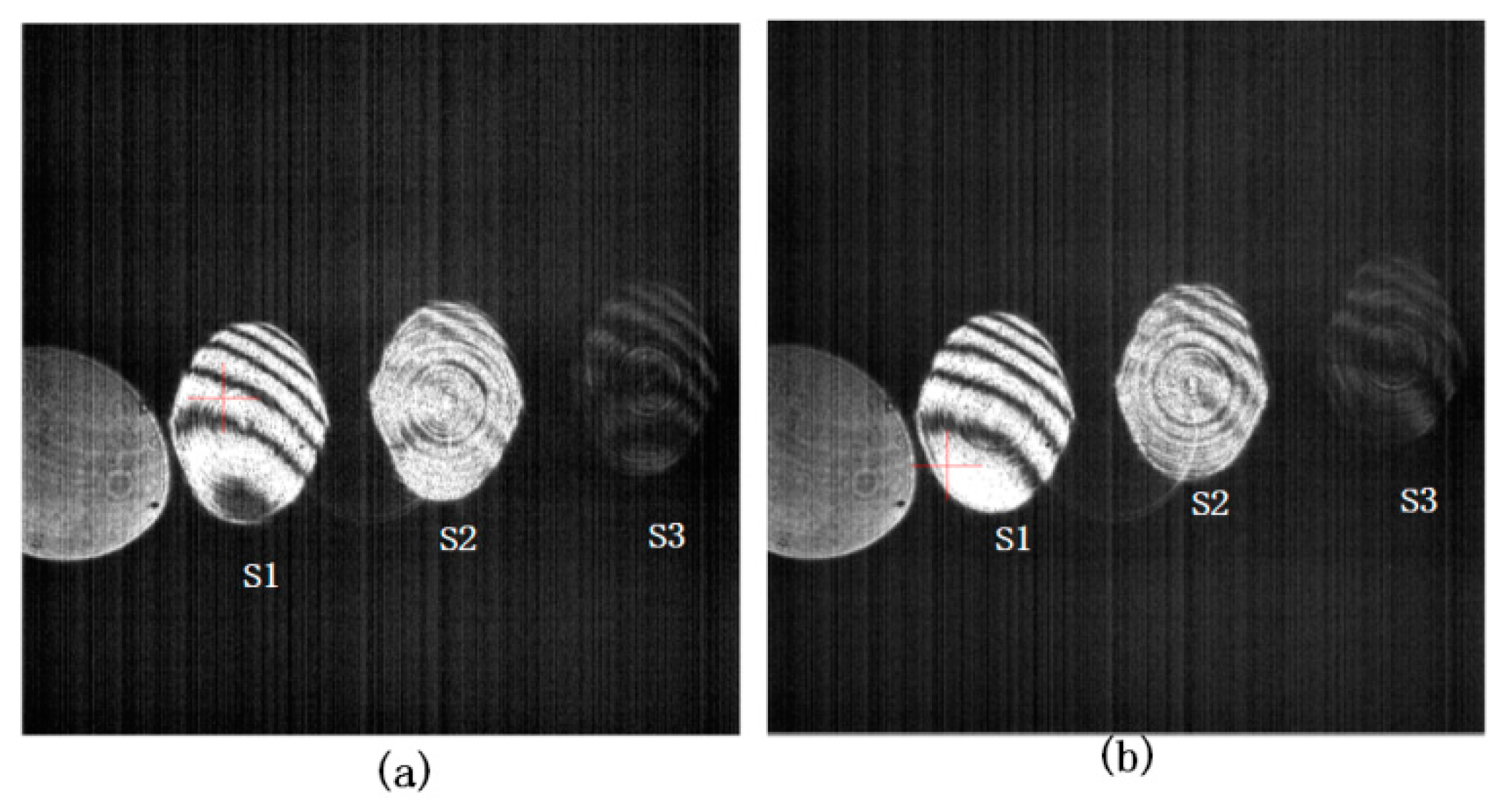
| Parameter | Value | Unit |
|---|---|---|
| VM Frequency | 3033 | Hz |
| VM Amplitude | rad | |
| MAV | 48.8 | |
| MAA | ||
| exposure time | 100 | ms |
| Camera Frame Rate | 10 | fps |
| LPW | 129 | ns |
| Laser wavelength λ | 532 | nm |
| rad | ||
| 476 | ns | |
| Location interval | 1494 | ns |
| 2 | m | |
| 90 (<495.5) | ns | |
| 221 |
© 2020 by the authors. Licensee MDPI, Basel, Switzerland. This article is an open access article distributed under the terms and conditions of the Creative Commons Attribution (CC BY) license (http://creativecommons.org/licenses/by/4.0/).
Share and Cite
Han, W.; Gao, X.; Fan, Z.; Bai, L.; Liu, B. Long Exposure Short Pulse Synchronous Phase Lock Method for Capturing High Dynamic Surface Shape. Sensors 2020, 20, 2550. https://doi.org/10.3390/s20092550
Han W, Gao X, Fan Z, Bai L, Liu B. Long Exposure Short Pulse Synchronous Phase Lock Method for Capturing High Dynamic Surface Shape. Sensors. 2020; 20(9):2550. https://doi.org/10.3390/s20092550
Chicago/Turabian StyleHan, Weiqiang, Xiaodong Gao, Zhenjie Fan, Le Bai, and Bo Liu. 2020. "Long Exposure Short Pulse Synchronous Phase Lock Method for Capturing High Dynamic Surface Shape" Sensors 20, no. 9: 2550. https://doi.org/10.3390/s20092550





